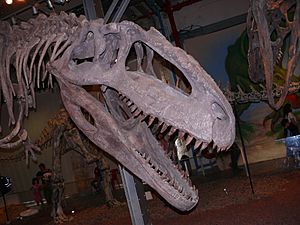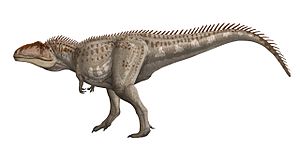Giganotosaurus facts for kids
Quick facts for kids GiganotosaurusTemporal range: Upper Cretaceous 97 mya
|
|
|---|---|
 |
|
| Replica of Giganotosaurus at the Australian Museum in Sydney. | |
| Scientific classification | |
| Kingdom: | |
| Class: | |
| Superorder: | |
| Order: | |
| Suborder: | |
| Family: | |
| Genus: |
Giganotosaurus
|
Giganotosaurus (say "JYE-ga-NO-toe-SORE-us") was a huge meat-eating dinosaur. It lived about 97 million years ago during the Upper Cretaceous Period. This makes it one of the largest land carnivores ever known. It was a bit bigger than Tyrannosaurus, but smaller than Spinosaurus. Scientists have found its fossils in Argentina, a country in South America.
The name Giganotosaurus means "giant southern lizard." This comes from Ancient Greek words: gigas (giant), notos (south wind), and -saurus (lizard).
Contents
Discovery and What We Know About Giganotosaurus
The first Giganotosaurus fossil was found by Ruben Carolini in 1993. He was an amateur fossil hunter. He discovered the bones in a place called Patagonia in southern Argentina. Scientists Rodolfo Coria and Leonardo Salgado officially described this new dinosaur in 1995.
The main fossil, called the holotype, was about 70% complete. It included parts of the skull, pelvis, leg bones, and most of the backbone. Scientists think this dinosaur was about 12.2 to 12.5 meters (40 to 41 feet) long. It probably weighed between 6.5 and 13.3 tons.
Another fossil, a piece of a jawbone, was also found. This jawbone was 8% larger than the one from the first fossil. This suggests that some Giganotosaurus individuals were even bigger! They might have had the largest skulls of any meat-eating dinosaur. Giganotosaurus was heavier than Tyrannosaurus by at least half a ton.
How Giganotosaurus Lived
Giganotosaurus carolinii was a bit larger than Tyrannosaurus rex. However, its brain was only about half the size of a T. rexs brain. The teeth of Giganotosaurus were shorter and narrower than Tyrannosaurus teeth. They were perfect for slicing through flesh.
This dinosaur likely had a very good sense of smell. This helped it find its prey. Even though its skull was large, it was quite slender.
Scientists have found fossils of huge plant-eating dinosaurs called Titanosaurs near Giganotosaurus remains. This makes them think that Giganotosaurus might have hunted these giant herbivores. Some related dinosaurs hunted in groups. This suggests that Giganotosaurus might have also hunted in packs. Hunting together would have helped them take down very large prey.
Scientists have estimated that Giganotosaurus could run quite fast. It might have reached speeds of up to 14 meters per second (31 miles per hour).
Family Tree of Giganotosaurus
Giganotosaurus belongs to a family of carnosaurs called Carcharodontosauridae. Other dinosaurs in this family include Tyrannotitan, Mapusaurus, and Carcharodontosaurus.
In 2006, scientists Coria and Currie placed Giganotosaurus and Mapusaurus into their own special group. This group is called Giganotosaurinae. This happened as more carcharodontosaurid dinosaurs were discovered and studied.
Giganotosaurus in Movies and Games
The real Giganotosaurus fossils are kept at the Carmen Funes Museum in Neuquén, Argentina. But you can see replicas in many other places, like the Australian Museum in Sydney.
Even though it was discovered recently, Giganotosaurus is becoming famous in popular culture.
- It appeared in the video game Dino Crisis 2. In the game, its size was made much bigger than it was in real life.
- Giganotosaurus was also featured in the TV special Chased by Dinosaurs. In this show, they hunted alone and in packs to bring down an Argentinosaurus.
- It was in the IMAX movie Dinosaurs: Giants of Patagonia. This movie showed the places where major dinosaur discoveries were made in Argentina.
- There's even a robot animal kit from the Zoids series based on it.
- Giganotosaurus appeared in the Dinotopia story The World Beneath.
- It was also in the third season of the TV show Primeval. In this show, it was shown as being able to run very fast for long distances.
Images for kids
-
Holotype skeleton with reconstructed skull, arm, and feet, on the floor in Ernesto Bachmann Paleontological Museum
-
Casts of Giganotosaurus and the contemporary sauropod Limaysaurus, Hungarian Natural History Museum
See also
 In Spanish: Giganotosaurus carolinii para niños
In Spanish: Giganotosaurus carolinii para niños












